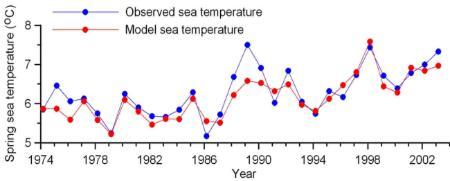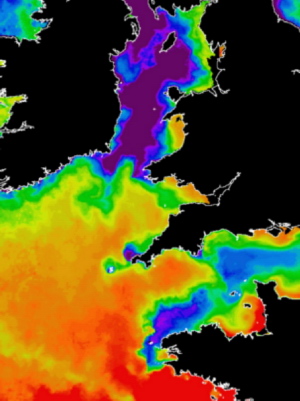Shelf seas and climate
|
The coastal and shelf seas are expected to experience (IPCC, 2007):
|
 |
| Figure 1. Observed warming of the north-eastern North Sea, showing an overall trend of +0.4°C per decade (compared to a global average of +0.1 to +0.2°C per decade). The 1-D numerical model successfully hindcast both the trend and the inter-annual variability. [After Sharples et al., 2006.] |
At Liverpool, the National Oceanography Centre (NOC) is investigating
- how shallow continental-shelf seas respond to effects of climate and human activity such as pollution and increased nutrients
- how the open ocean affects shelf seas and how shelf seas exchange water and its contents with the ocean (Fig. 2).
|
|
|
Figure 2. A typical summer sea surface temperature image of the Celtic and Irish Seas, from the Advanced Very High Resolution Radiometer satellite sensor. Orange and red (17 – 19°C) shows areas of relatively weak tides where summer stratification has developed. Purple and blue (12 – 14°C) shows tidally energetic regions where the water remains vertically-mixed all year. Sharp tidal mixing fronts (between Ireland/Southwest Wales) separate the stratified and mixed regions. A band of cooler water (southwest of Britanny) lies along the continental shelf edge due to strong mixing by an internal tide. The partitioning into mixed, frontal, and stratified regions is consistent between years. Image supplied by Remote Sensing Division, Plymouth Marine Laboratory, NERC
|
At Liverpool, the Proudman Oceanography Laboratory (POL) is investigating
- how shallow continental-shelf seas respond to effects of climate and human activity such as pollution and increased nutrients
- how the open ocean affects shelf seas and how shelf seas exchange water and its contentswith the ocean
Presentations in the Marine Sciences Symposium 2008 'Climate change: the science and the impacts - a Liverpool perspective' by
-
Chris Frid et al. (SoBS) Understanding seabed ecology: climate, fisheries and food
-
Jason Holt et al. (POL) Modelling carbon fluxes and budgets of the NW European shelf
References
- Sharples, J., O. N. Ross, B. E. Scott, S. P. R. Greenstreet, and H. Fraser (2006). Inter-annual variability in the timing of stratification and the spring bloom in the North-western North Sea. Continental Shelf Research, 26, 733-751.
